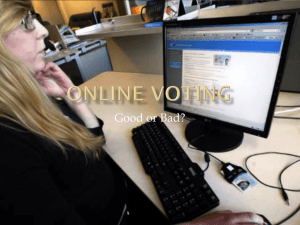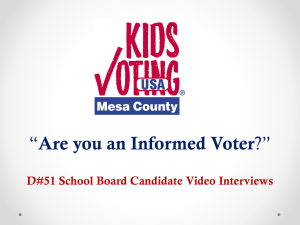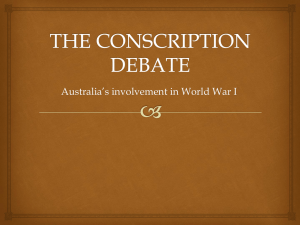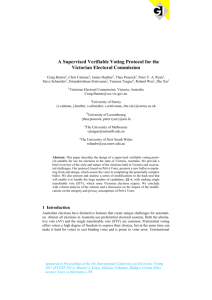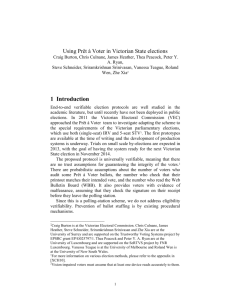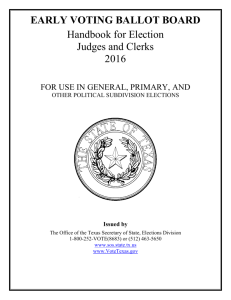Participation in the Democratic Process
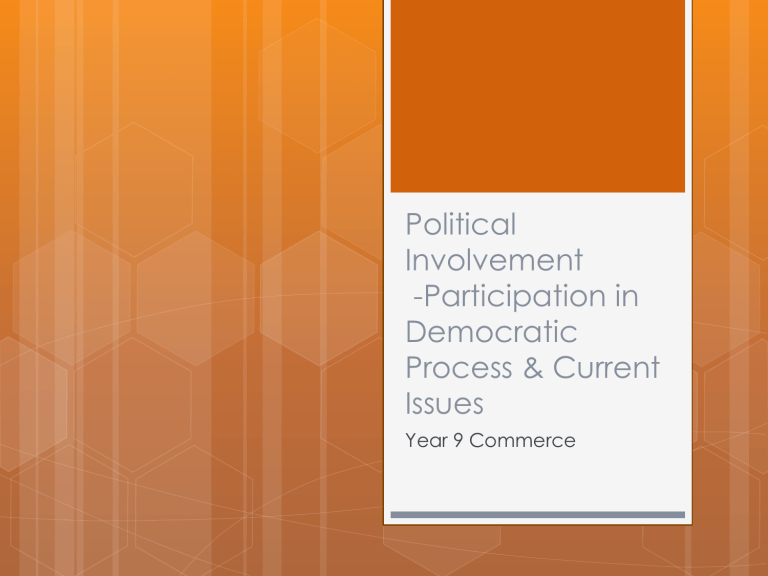
Political
Involvement
-Participation in
Democratic
Process & Current
Issues
Year 9 Commerce
Syllabus
Participation in the democratic process
right to vote
methods of voting
first past the post preferential optional preferential proportional role and function of political parties role and strategies of pressure groups rights and responsibilities of individuals and groups in the democratic process
Current issues
current issues involving the political process
Participation in the democratic process
LINGO LIST
Ballot paper
A paper listing the names of the people (candidates) who are seeking a place in parliament, and on which the voter marks his or her choice or choices.
Donkey vote
A ballot paper where the voter has simply numbered the candidates in the order in which they appear on the ballot paper.
Electoral commissioner
The official who is responsible for the conduct of elections, including ensuring that electoral laws are obeyed.
Federation
The term given to the founding of the Australian nation in 1901. The colonial states gave up some of their powers and responsibilities to a national government.
Informal vote
A ballot paper that has not been filled out correctly or has been defaced in some way. Voters sometimes do this on purpose as a form of protest.
(Optional) preferential proportional representation
A system where, for the election of one candidate, the voter only needs to indicate a preference for the candidate of his or her choice, but may also mark a preference for all or some of the remaining candidates on the ballot paper.
(Preferences) Choices or options.
preferential voting A system of voting in which a voter shows an order of preference for candidates, giving the number one to his or her first choice through to the last number to the last choice
Methods Of Voting
First past the post
Preferential
First-past-the-post
In this system the candidate who receives the most votes wins.
This system was initially used for federal elections, beginning with Federation in 1901, and continued as the main form of voting in federal elections until
1918.
It is no longer used in political elections in Australia and has been replaced by preferential voting at federal, state and local government levels.
Under the first-past-the-post system, the voter puts an ‘X’ in the box next to the preferred candidate’s name and leaves the other boxes blank.
The candidate with the most votes (or ‘X’s next to his or her name) is declared the winner. It is the most straightforward way of voting.
Preferential
In preferential voting, voters must show their preferences by giving each candidate a number.
The most preferred candidate is given the number 1, the next preferred candidate is given the number 2 and so on until all the candidates have been numbered.
For the vote to count, all candidates must have a number against their names.
If the ballot paper is incomplete, has a number repeated or missing or is illegible it is considered an informal vote and is not counted.
When an elector simply numbers the candidates sequentially down the ballot paper it is called a donkey
vote.
To win a seat in parliament under this system of voting, a candidate must receive 50 per cent of the vote plus 1 vote.
Role Of Political Parties
Political parties are the chief means by which political power is exercised in Australia.
They draw together people who have similar political ideas.
While these people may not agree on all matters, the party does provide a means for people of broadly similar interests to meet and to develop and promote their ideas.
They also offer the best chance for implementing these ideas if the political party is in a position to form a government.
Two major political parties dominate Australia’s political system. The Australian Labor Party and the Liberal Party of
Australia with its coalition partner, the Nationals are the two largest political parties. Smaller political parties include the
Greens.
Function Of Political Parties
Political parties play an important role in the stability of our political system.
If parties did not exist, each individual member of parliament would be free to make up his or her own mind on every issue that came before the parliament.
This would be impractical.
It would make it difficult to get unpopular but necessary legislation through the parliament.
It could also encourage unethical behaviour.
Role And Strategies Of
Pressure (Interest) Groups
Everybody in Australia, including those under the voting age, can become a member of a political party, most people choose not to become actively involved in politics.
Less than 1 per cent of Australians are members of a political party.
More people feel comfortable about joining or supporting an interest group.
Many do so without even realising it.
For example, the NRMA−a motorist organisation to which many people belong−provides much more than just road service. It is a powerful interest group promoting the concerns of automobile owners. It lobbies governments for additional road funding and acts as a consumer watchdog in matters relating to automobile quality and safety.
interest groups are often compared with political parties because both are organisations that communicate the views and concerns of citizens to governments.
Interest groups have three features that set them apart from political parties:
They don’t seek to win elections.
They often campaign continuously on issues, whereas political parties tend to be most active in the period immediately before elections.
Interest groups are more issue orientated than political parties and depend on supporters who identify with their organisation. Political parties often depend on mobilising voters to support a particular candidate or party rather than any one issue.
Interest Groups v Political
Parties
Research Activity
Research an Australian Interest group from the list below:
The Ark www.users.fl.net.au/~ark
Ausflag www.ausflag.com.au/
Australian Chamber of Commerce and Industry www.acci.asn.au/
Australian Council of Trade Unions www.actu.asn.au/
Australian Medical Association www.ama.com.au/
Australian Nursing Federation www.anf.org.au/
Business Council of Australia www.bca.com.au/
Diabetes Australia www.diabetesaustralia.com.au/
Electrical Trades Union www.etunsw.asn.au
Festival of Light www.fol.org.au/
National Farmers’ Federation www.nff.org.au/
Chapter review
1. The type of federal government that
Australia has is called a: a monarchy b federation c constitutional democracy d tyranny
2. Australia has: a one level of government b two levels of government c three levels of government d four levels of government
3 The state government is responsible for: a migration, economy and education b migration, education and health c health, education and roads d libraries, education and garbage collection
4 The main organisations that have an impact on decision making are: a governments b business c welfare organisations and the media d all of the above
Chapter review
5. A donkey vote is: a a vote that is numbered sequentially down the ballot paper b a vote cast by a donkey c one where the voter has written a comment on the ballot paper d none of the above
6. The Legislative Council is also known as the: a Lower House b Upper House c Cabinet d quorum
Chapter review
7 The leader of the federal government is called the: a governor-general b prime minister c premier d chief
8 A deputation is: a a group of students who go to see the deputy principal b a group of people appointed to represent others c an interest group that uses direct action d an individual who is not associated with a political party




